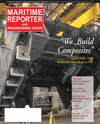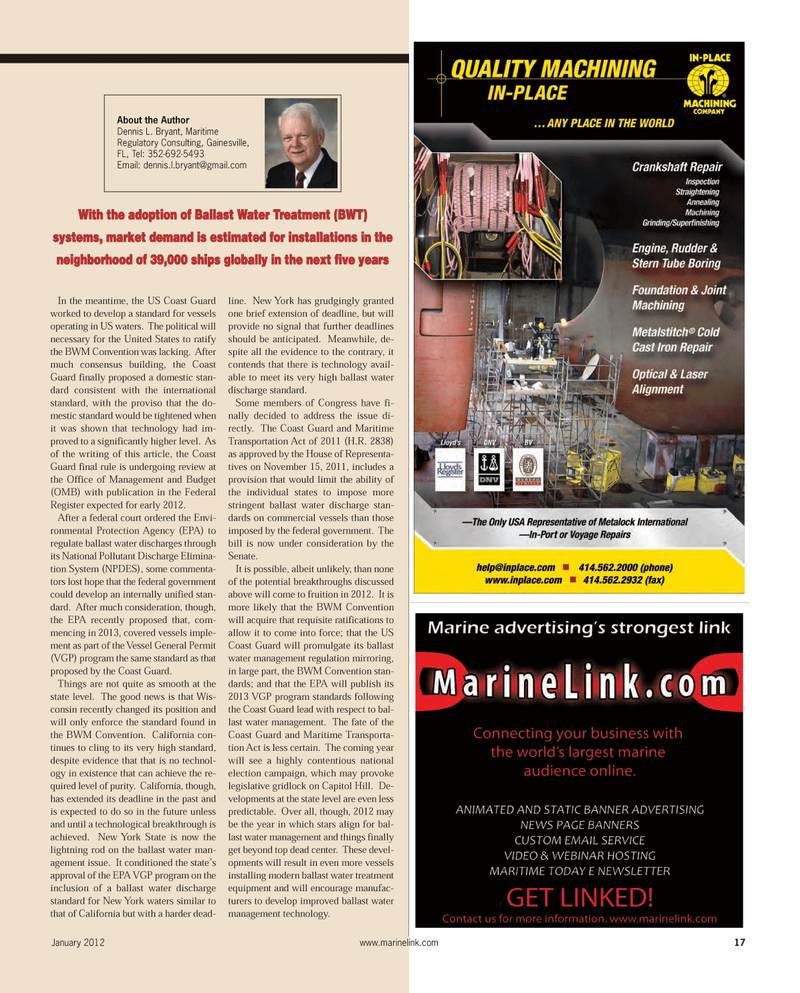
Page 17: of Maritime Reporter Magazine (January 2012)
US Navy Report
Read this page in Pdf, Flash or Html5 edition of January 2012 Maritime Reporter Magazine
January 2012www.marinelink.com 17In the meantime, the US Coast Guardworked to develop a standard for vessels operating in US waters. The political will necessary for the United States to ratifythe BWM Convention was lacking. After much consensus building, the Coast Guard finally proposed a domestic stan- dard consistent with the internationalstandard, with the proviso that the do- mestic standard would be tightened when it was shown that technology had im- proved to a significantly higher level. As of the writing of this article, the CoastGuard final rule is undergoing review at the Office of Management and Budget (OMB) with publication in the FederalRegister expected for early 2012. After a federal court ordered the Envi- ronmental Protection Agency (EPA) to regulate ballast water discharges through its National Pollutant Discharge Elimina- tion System (NPDES), some commenta-tors lost hope that the federal government could develop an internally unified stan- dard. After much consideration, though, the EPA recently proposed that, com- mencing in 2013, covered vessels imple- ment as part of the Vessel General Permit (VGP) program the same standard as that proposed by the Coast Guard.Things are not quite as smooth at thestate level. The good news is that Wis- consin recently changed its position andwill only enforce the standard found inthe BWM Convention. California con- tinues to cling to its very high standard, despite evidence that that is no technol- ogy in existence that can achieve the re- quired level of purity. California, though, has extended its deadline in the past and is expected to do so in the future unless and until a technological breakthrough isachieved. New York State is now the lightning rod on the ballast water man- agement issue. It conditioned the state?s approval of the EPA VGP program on the inclusion of a ballast water discharge standard for New York waters similar to that of California but with a harder dead- line. New York has grudgingly granted one brief extension of deadline, but will provide no signal that further deadlines should be anticipated. Meanwhile, de-spite all the evidence to the contrary, it contends that there is technology avail- able to meet its very high ballast water discharge standard. Some members of Congress have fi- nally decided to address the issue di-rectly. The Coast Guard and Maritime Transportation Act of 2011 (H.R. 2838) as approved by the House of Representa- tives on November 15, 2011, includes a provision that would limit the ability of the individual states to impose more stringent ballast water discharge stan- dards on commercial vessels than those imposed by the federal government. The bill is now under consideration by the Senate.It is possible, albeit unlikely, than none of the potential breakthroughs discussedabove will come to fruition in 2012. It is more likely that the BWM Convention will acquire that requisite ratifications to allow it to come into force; that the US Coast Guard will promulgate its ballast water management regulation mirroring, in large part, the BWM Convention stan- dards; and that the EPA will publish its 2013 VGP program standards following the Coast Guard lead with respect to bal-last water management. The fate of the Coast Guard and Maritime Transporta- tion Act is less certain. The coming year will see a highly contentious nationalelection campaign, which may provoke legislative gridlock on Capitol Hill. De- velopments at the state level are even less predictable. Over all, though, 2012 may be the year in which stars align for bal-last water management and things finally get beyond top dead center. These devel- opments will result in even more vessels installing modern ballast water treatment equipment and will encourage manufac- turers to develop improved ballast water management technology. About the AuthorDennis L. Bryant, Maritime Regulatory Consulting, Gainesville,FL, Tel: 352-692-5493 Email: [email protected] the adoption of Ballast Water Treatment (BWT) systems, market demand is estimated for installations in theneighborhood of 39,000 ships globally in the next five yearsMR Jan.12 # 2 (10-17):MR Template 1/10/2012 12:08 PM Page 17

 16
16

 18
18
